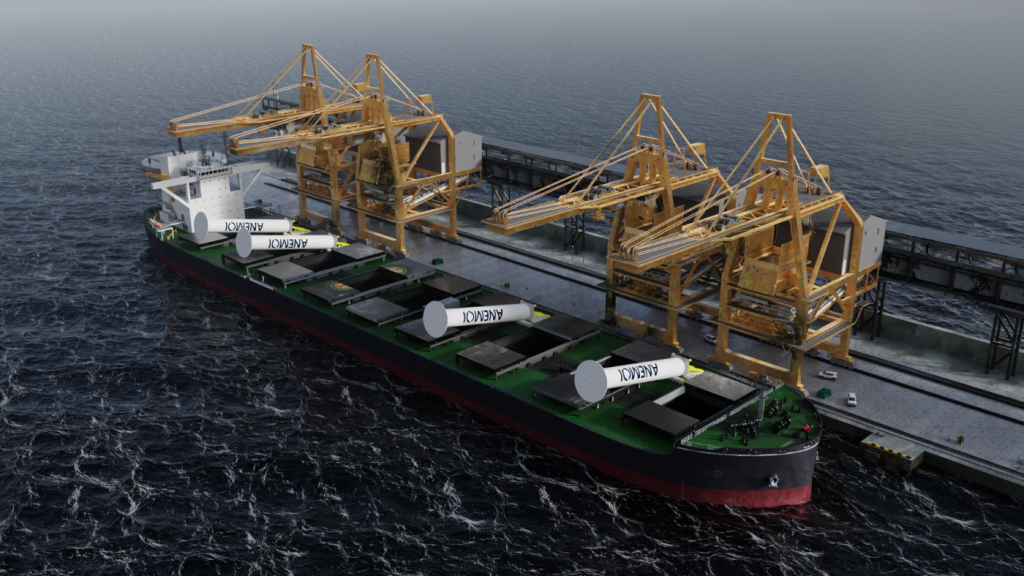
The Republic of the Marshall Islands (RMI) Maritime Administrator has recently granted Approval in Principle (AiP) to Anemoi Marine Technologies (Anemoi) for their innovative Rotor Sail systems. This milestone comes after a meticulous evaluation of two distinct configurations of this wind-propulsion technology, showcasing the administration’s commitment to fostering advancements in safety and environmental performance within the maritime industry.
Harnessing Wind Power for Efficiency and Emission Reduction
Rotor Sails, also recognized as “Flettner” rotors, stand as vertical cylinders designed to harness wind power
for additional forward thrust in vessels, concurrently enhancing energy efficiency and reducing carbon emissions. The AiP awarded to Anemoi followed an extensive review of a 210,000 deadweight ton (DWT) Newcastlemax bulk carrier. This vessel, designed by Shanghai Merchant Ship Design & Research Institute (SDARI), featured Anemoi’s four Rotor Sails (measuring 5 meters (m) x 35 m) with a folding deployment system and six Rotor Sails (measuring 5 m x 30 m) with a bespoke rail deployment system.

Impact on Energy Efficiency Design Index (EEDI)
The RMI Maritime Administrator’s approval also included a technical assessment of the Rotor Sail installations in both configurations, focusing on their impact on the vessel’s Energy Efficiency Design Index (EEDI) calculations. The estimated improvements were noteworthy, with a 20% enhancement projected for the rail system and a 17% improvement for the folding deployment system concerning the vessel’s EEDI.
Jasbir Jaspal, Deputy Commissioner of Maritime Affairs at RMI Maritime Administrator, expressed the organization’s dedication to supporting industry initiatives for safety and environmental enhancements. Jaspal emphasized the significance of Anemoi’s Rotor Sail systems in allowing the commercial shipping industry to harness wind energy for propulsion, contributing to a substantial reduction in carbon footprint.
Anemoi’s CEO Optimistic About the Future
Kim Diederichsen, Chief Executive Officer of Anemoi, expressed delight at receiving support from the RMI for their Rotor Sail technology. He emphasized that wind propulsion has found its place in modern commercial shipping, and this partnership signifies a step forward in showcasing the positive impact of Rotor Sails. Diederichsen anticipates a lasting relationship with one of the world’s leading flag States, working collaboratively to advance decarbonization efforts and enhance vessel efficiency goals.

Real-world Application on RMI Flagged Vessels
Anemoi’s Rotor Sails have already found application on several RMI-flagged vessels. The installation of the rail deployment system was completed in June 2023 on the 82,000 DWT TR LADY Kamsarmax bulk carrier. Another notable project is the 400,000 DWT SOHAR MAX very large ore carrier, scheduled for completion in mid-2024, featuring Anemoi’s folding deployment system. These installations are expected to provide additional thrust, enhance energy efficiency, and substantially reduce the total carbon footprint of these vessels.
Meeting International Emission Reduction Targets
The maritime industry is increasingly turning to Rotor Sails as a pivotal energy-saving technology to meet critical international emission reduction targets. These include the Energy Efficiency Existing Ship Index (EEXI) and the Carbon Intensity Indicator (CII). For instance, the installation of three Anemoi Rotor Sails on the TR LADY is projected to save over 10% on fuel and emissions annually. Similarly, the inclusion of Rotor Sails on the SOHAR MAX is anticipated to decrease CO2 equivalent emissions by up to 3,000 tonnes per year.
